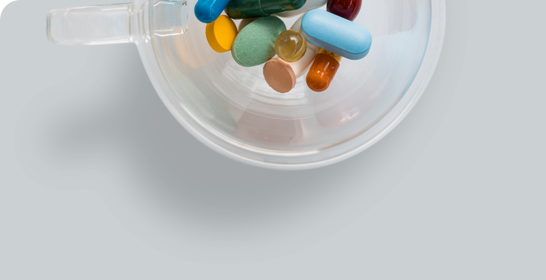We use cookies to make your experience better. To comply with the new e-Privacy directive, we need to ask for your consent to set the cookies. Learn more.
ActiHyal - Hyaluronic Acid
ActiHyal - Hyaluronic Acid
ActiHyal Key Facts
(3 kDa) to high (2.6M Da), catering to diverse application needs in cosmetics, nutraceuticals, and pharmaceuticals.
Download Product Brochure
Background
Hyaluronic acid (HA) is a macromolecule that plays an important role in the human body and has a wide range of applications into consumer products and pharmaceuticals thanks to its unique physicochemical properties and involvement in various essential biological processes (Salih et al., 2024). It plays a vital role in moisture retention in the skin and in joint movement. However, with age, the levels of HA in our body begins to decline. In fact, the skin’s HA content starts to decrease in as early as 20 years old and is reduced to half by the age of 50. This reduction in HA levels lower your skins moisturizing capacity and alongside similar drops in collagen levels is linked to the appearance of fine lines and wrinkles (Goberdhan et al., 2016).HA's biological functions are as diverse as they are significant. In the body, it exists in sodium hyaluronate and is present in various soft connective tissues, including the skin, lungs, kidneys, brain, eyes and muscle tissues (Necas et al., 2008). When bound to water molecules, HA forms a hydrated gel and acts as a water-binding agent that lubricates movable body parts, such as joints and muscles.
These broad functions and properties mean that HA has been studied in great depth, and is used in a wide range of applications throughout the medical health, food and supplements, and cosmetic fields.
Chemistry
HA is a biopolymer composed of repeating units of disaccharides, which include molecules of D-glucuronic acid and N-acetylglucosamine molecules linked by β- (1–4) and β- (1–3)glycosides with a molecular weight of approximately 400 Da. It belongs to a group of substances called mucopolysaccharides, and is part of the glycosaminoglycans (GAGs) family - a family of structurally complex, linear, anionic, hetero-co-polysaccharides (Salwowska et al., 2016). An intact HA polysaccharide chains can be comprised of as many as 25,000 disaccharide units, corresponding to a molecular weight of up to 7 million Dalton (M Da).Hyaluronic acid sodium salt
CAS – 9067-32-7EC – 618-620-0
Molecular Formula – (C14H21NaNO11)n
Molecular Weight – 403.31 g/ mol
IUPAC – (1→4)-(2-Acetamido-2-deoxy-D-gluco)-(1→3)-D-glucuronoglycan
Purity and Production
Traditionally HA was extracted from rooster combs, however, it is now it is mainly produced via streptococcal fermentation (Liu et al., 2011). The production of fermentation-origin HA involves the continuous fermentation of Streptococcus in a controlled culture environment, such as a chemostat. However, it is important to note that fermentation-origin HA often contains high amounts of endotoxins and elevated bacterial levels, which necessitate the removal of these impurities through subsequent purification steps (Lapčík et al., 1998). Therefore, additional purification steps are required to minimize the presence of bacterial proteins.Molecular Weights
Different molecular weights of HA influence its biological properties, absorption, and functional characteristics – each of which has a distinct implication for end applications.Low molecular weight (LMW) hyaluronic acid, due to its smaller size, is absorbed quickly and effectively used in both nutritional supplements to support joint health and in lightweight serums for deep skin penetration.
Mid molecular weight (MMW) provides an optimal balance suitable for ophthalmic uses such as eye drops for dry eye relief and for long-lasting facial moisturizers that retain hydration without heavy residue.
High molecular weight (HMW) is characterised by its high viscosity, making it ideal for dermal fillers and injectables that require structural support and longevity, as well as in viscosupplements for osteoarthritis treatment, where it acts as a cushion within the joint space. These variations ensure that HA can be tailored to meet specific needs across medical, cosmetic, and nutritional fields, enhancing its versatility and efficacy in various applications (Snetkov et al., 2020).
ActiHyal is available in different forms
ActiHyal - Hyaluronic acid sodium salt powder [Food grade] [0.8M Da to 1.5M Da]
ActiHyal - Hyaluronic acid sodium salt powder [Food grade] [0.5 MDa to 0.8 MDa]
ActiHyal - Hyaluronic acid sodium salt powder [Food grade] [50 kDa to 100 kDa]
ActiHyal - Hyaluronic acid sodium salt powder [Food grade] [3 kDa to 8 kDa]
Hyaluronic Acid and Health
Download Product Brochure
Oral administration
In recent years, clinical trials were carried out to reveal that oral administration of HA can effectively improve skin condition. Indeed, multiple placebo-controlled trials using LMW-HA on patients with dry skin, have suggested that oral administration of HA significantly increased skin hydration and improved skin dryness (Gao et al., 2023). For example, in a 2015 trial of 61 patients with dry skin using HMW-HA, a significant improvement in skin hydration was reported(Kawada et al., 2015), while a 2012 study reported that oral administration of HA was able to alleviate aging symptoms on facial skin (Schwartz and Park, 2012).A 2023 clinical trial randomly assigned 129 females of varying age and skin types to receive either HA or placebo for 12 weeks. The study found that oral administration of HA significantly promoted skin hydration after 2-8 weeks among both young and elderly groups, while skin tone improvement was observed after 4-8 weeks, and an increase in epidermal thickness was noted after 12 weeks (Gao et al., 2023).
Topical use
A 2016 study reported that twice daily application of HA resulted in statistically significant improvement in overall skin appearance, fine (periocular, forehead) lines/wrinkles, coarse (periocular, forehead) lines/wrinkles, and tactile roughness (all P ≤ .04) were observed at weeks 1 and 4. (Goberdhan et al., 2016)A different open-label clinical trial found that the use of a topical serum containing HA twice daily resulted in increased skin hydration (p < 0.0001), decreased fine lines / wrinkling, crepiness, texture, erythema, and dryness (p < 0.0001). Furthermore, histology revealed increased CD44 staining in 6 of the 7 participants biopsied, denoting increased HA stimulation (Robinson et al., 2022).
Medical use
A multi-centre clinical trial in France and Germany assessing the effects of intra-articular injections with LMW-HA and MMW-HA in patients with knee osteoarthritis found those treated with MMW injections had lower pain scores and demonstrated a higher OARSI-OMERACT responder percentage (Berenbaum et al., 2012). HA is also used in the treatment of ophthalmic, dermal, burns, wound repair, and other health conditions.Due to its biocompatibility, biodegradability, non-toxicity, and non-immunogenicity, HA has also become an interesting target for use in biomedical products, including applications in rheumatology, ophthalmology, local anaesthetics, cancer treatment and bioengineering of tissues.
A review from 2021 noted that a many potentially beneficial actives being developed in the medical and pharmaceutical space have been seen too present significant limitations in terms of their solubility, stability, and the development of systemic side-effects. As a result, a major focus for such new development has been the potential for polymers such as HA as a drug delivery system(Harrer et al., 2021). Indeed, when encapsulated in a nanocarrier, HA may help to improve delivery and sustained release of active pharmaceutical ingredients and can also be used as a biodegradable scaffold for medical uses (Vasvani, Kulkarni and Rawtani, 2020).
Thanks to its good biocompatibility, enzymatic degradation, and easy modification HA has been successfully used as a nanocarrier for drug delivery in cancer chemotherapy (Salari et al., 2021). In fact, studies have linked the use of HA-based nanocarriers as a drug delivery method to decreasing tumour growth, enhancing the patient’s quality of life, and minimizing drug toxicity (Yu et al., 2020).
Bioavailability
Studies showed that orally ingested high-molecular-weight HA (HMM-HA, MW≥100 kDa) does not undergo significant degradation in gastric fluid, (de Souza, Chaud and Santana, 2019) and is taken up by intestinal epithelial cells, M cells, dendritic cells, and macrophages (Gao et al., 2023). In the lower intestinal epithelial cells, HMH-HA interacts with TLR-4 receptors, enabling it to be absorbed by intestinal cells (Asari, Kanemitsu and Kurihara, 2010). Scintigraphic imaging showed gut-associated lymphoid tissue (GALT) took up intact HMM-HA molecules and distributed them in connective tissues after 4 h, with orally ingested HA appearing in the joints, vertebrae, and salivary glands (Balogh et al., 2008). In a similar study, orally ingested labelled HMM-HA entered the bloodstream in its biologically active form and was transported to its destination without undergoing dissociation (Kawada et al., 2014). Studies have shown that orally ingested low molecular weight HA (LMW-HA, MW < 100 kDa) is mainly absorbed in the cecum and transported throughout the body via the bloodstream (Kimura et al., 2016).Trademark
ActiHyal is a trademark of Vita Actives, EU trademark number 018983782.References
- Asari, A., Kanemitsu, T. and Kurihara, H. (2010) ‘Oral administration of high molecular weight hyaluronan (900 kDa) controls immune system via toll-like receptor 4 in the intestinal epithelium’, Journal of Biological Chemistry, 285(32), pp. 24751–24758. Available at: https://doi.org/10.1074/JBC.M110.104950.
- Balogh, L. et al. (2008) ‘Absorption, uptake and tissue affinity of high-molecular-weight hyaluronan after oral administration in rats and dogs’, Journal of Agricultural and Food Chemistry, 56(22), pp. 10582–10593. Available at: https://doi.org/10.1021/JF8017029.
- Berenbaum, F. et al. (2012) ‘A randomised, double-blind, controlled trial comparing two intra-articular hyaluronic acid preparations differing by their molecular weight in symptomatic knee osteoarthritis’, Annals of the Rheumatic Diseases, 71(9), pp. 1454–1460. Available at: https://doi.org/10.1136/ANNRHEUMDIS-2011-200972.
- Gao, Y.R. et al. (2023) ‘Oral administration of hyaluronic acid to improve skin conditions via a randomized double-blind clinical test’, Skin Research and Technology, 29(11), p. e13531. Available at: https://doi.org/10.1111/SRT.13531.
- Goberdhan, L. et al. (2016) ‘Immediate and long-term effects of a topical serum with five forms of hyaluronic acid on facial wrinkles and intrinsic skin moisture content’, Journal of the American Academy of Dermatology, 74(5), p. AB18. Available at: https://doi.org/10.1016/j.jaad.2016.02.072.
- Harrer, D. et al. (2021) ‘Is hyaluronic acid the perfect excipient for the pharmaceutical need?’, International Journal of Pharmaceutics, 601. Available at: https://doi.org/10.1016/J.IJPHARM.2021.120589.
- Kawada, C. et al. (2014) ‘Ingested hyaluronan moisturizes dry skin’, Nutrition Journal, 13(1). Available at: https://doi.org/10.1186/1475-2891-13-70.
- Kawada, C. et al. (2015) ‘Ingestion of hyaluronans (molecular weights 800 k and 300 k) improves dry skin conditions: a randomized, double blind, controlled study’, Journal of Clinical Biochemistry and Nutrition, 56(1), pp. 66–73. Available at: https://doi.org/10.3164/JCBN.14-81.
- Kimura, M. et al. (2016) ‘Absorption of Orally Administered Hyaluronan’, Journal of Medicinal Food, 19(12), pp. 1172–1179. Available at: https://doi.org/10.1089/JMF.2016.3725.
- Lapčík, L. et al. (1998) ‘Hyaluronan: Preparation, Structure, Properties, and Applications†’, Chemical Reviews, 98(8). Available at: https://doi.org/10.1021/CR941199Z.
- Liu, L. et al. (2011) ‘Microbial production of hyaluronic acid: current state, challenges, and perspectives’, Microbial Cell Factories, 10. Available at: https://doi.org/10.1186/1475-2859-10-99.
- Necas, J. et al. (2008) ‘Hyaluronic acid (hyaluronan): a review’, Vet Med, 53(8), pp. 397–411. Available at: https://doi.org/10.17221/1930-vetmed.
- Robinson, D.M. et al. (2022) ‘Multicenter evaluation of a topical hyaluronic acid serum’, Journal of Cosmetic Dermatology, 21(9), pp. 3848–3858. Available at: https://doi.org/10.1111/JOCD.15241.
- Salari, N. et al. (2021) ‘Hyaluronic acid-based drug nanocarriers as a novel drug delivery system for cancer chemotherapy: A systematic review’, DARU Journal of Pharmaceutical Sciences, 29(2), p. 439. Available at: https://doi.org/10.1007/S40199-021-00416-6.
- Salih, A.R.C. et al. (2024) ‘Hyaluronic acid: comprehensive review of a multifunctional biopolymer’, Future Journal of Pharmaceutical Sciences 2024 10:1, 10(1), pp. 1–21. Available at: https://doi.org/10.1186/S43094-024-00636-Y.
- Salwowska, N.M. et al. (2016) ‘Physiochemical properties and application of hyaluronic acid: a systematic review’, J Cosmet Dermatol, 15(4), pp. 520–526. Available at: https://doi.org/10.1111/jocd.12237.
- Schwartz, S.R. and Park, J. (2012) ‘Ingestion of BioCell Collagen®, a novel hydrolyzed chicken sternal cartilage extract; enhanced blood microcirculation and reduced facial aging signs’, Clinical Interventions in Aging, 7, pp. 267–273. Available at: https://doi.org/10.2147/CIA.S32836.
- Snetkov, P. et al. (2020) ‘Hyaluronic acid: The influence of molecular weight on structural, physical, physico-chemical, and degradable properties of biopolymer’, Polymers, 12(8). Available at: https://doi.org/10.3390/POLYM12081800.
- Souza, A.B., Chaud, M. V. and Santana, M.H.A. (2019) ‘Hyaluronic acid behavior in oral administration and perspectives for nanotechnology-based formulations: A review’, Carbohydrate Polymers, 222. Available at: https://doi.org/10.1016/J.CARBPOL.2019.115001.
- Vasvani, S., Kulkarni, P. and Rawtani, D. (2020) ‘Hyaluronic acid: A review on its biology, aspects of drug delivery, route of administrations and a special emphasis on its approved marketed products and recent clinical studies’, International journal of biological macromolecules, 151, pp. 1012–1029. Available at: https://doi.org/10.1016/J.IJBIOMAC.2019.11.066.
- Yu, T. et al. (2020) ‘Development of a Hyaluronic Acid-Based Nanocarrier Incorporating Doxorubicin and Cisplatin as a pH-Sensitive and CD44-Targeted Anti-Breast Cancer Drug Delivery System’, Frontiers in pharmacology, 11. Available at: https://doi.org/10.3389/FPHAR.2020.532457.
Write Your Own Review
Explore your sector
Vita Actives manufacture, source, stock and distribute the highest quality bulk ingredients for pharmaceutical, nutraceutical, cosmeceutical and veterinary finished product manufacturers. We also supply tailor-made raw materials and finished nutritional supplements.




